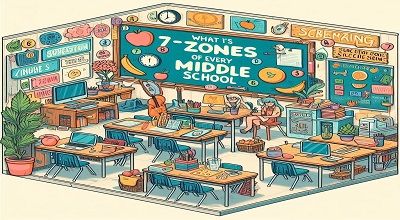7 Zones of Every Middle School Classroom
Now here, What are the 7 Zones of Every Middle School Classroom? The concept of dividing a middle school classroom into specific “zones” may vary depending on the educational philosophy or teaching approach used by a particular teacher or school. However, a common way to think about organizing a middle school classroom involves several key areas or zones that serve different purposes. These zones help create an effective and engaging learning environment.
Here are seven common zones in a middle school classroom:
- Instructional Zone: This is the front of the classroom where the teacher delivers lessons and instructions. It typically includes the whiteboard or chalkboard, the teacher’s desk, and a designated area for whole-group instruction.
- Student Work Zones: These areas include individual desks or tables where students sit and complete assignments or work on projects. This is where most of the individual or group work takes place.
- Reading Nook or Library: A comfortable and inviting area with books, magazines, and other reading materials. It encourages independent reading and can serve as a quiet place for students to relax.
- Technology Zone: A designated area where students can access computers, tablets, or other electronic devices for research, online assignments, or educational games. This area may also include charging stations and a classroom printer.
- Collaboration Zone: A space where students can work together in small groups, discuss projects, and engage in collaborative activities. This area is often furnished with tables, chairs, and whiteboards or bulletin boards for brainstorming and organizing ideas.
- Teacher’s Workspace: This is the area where the teacher’s desk, teaching materials, and resources are located. It serves as the teacher’s organizational hub.
- Art Display or Bulletin Board: A section of the classroom dedicated to displaying student work, educational posters, and class announcements. It can be a visually engaging area that changes throughout the school year.
Summary
Remember that the organization of a classroom can vary widely based on the teacher’s teaching style, grade level, classroom size, and the specific needs of the students. Some teachers may use flexible seating arrangements, while others may prefer traditional rows of desks. The goal of these different zones is to create a versatile and conducive learning environment that supports various teaching and learning activities.
